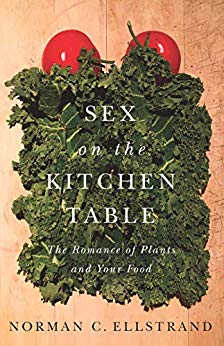Sex on the Kitchen Table
- By Norman C. Ellstrand
- University of Chicago Press
- 208 pp.
- Reviewed by Jenny Ferguson
- September 21, 2019
A professor reminds us of the living — and sensual? — things on our plate.

Sex and food.
That should catch your attention.
“The combination of those elements became the alloy that built my scientific career,” says Norman C. Ellstrand in his new “foodie sex manual” — an exploration of the plants that produce the food we eat.
Ellstrand is a professor who teaches biology to non-majors, which makes him well-suited to write for a general audience. His explanations of plant science are clear and easy to understand for those of us whose last bio class was in high school. The balance between anecdotes, the occasional joke, and the breakdown of complex information creates an accessible read.
“Ripe tomatoes are red, heart-shaped, and hopelessly sexy. Some romantic individuals believed that the tomato, with proper dosage, had aphrodisiacal properties, which explains its old French name: la pomme d’amour (love apple).”
Some facts in this very readable exploration of plant sex are historical or based in culture, while others dive into the depths of science. But even the latter are presented stripped down to the basics, with just enough detail to advance the reader’s understanding: “Flowering plants are also known as angiosperms, referring to the fact that seed (sperm) are borne in a fruit (angio- meaning ‘closed container’).”
While the cutesy carnal metaphors can get a bit tiresome, the recipes at the end of chapters are a delightful way to share the reproductive results of plants with readers while connecting our understanding of food to our understanding of the pervasive role plant sexuality plays in the lives of humans. All while mixing in the important role we play in the reproduction of plants.
This book aims to expose the depths of this ecosystem for readers who might, say, know that the avocado is a fruit with a large seed at its center, but who forget that the flesh of the avocado is meant to nurture and protect that seed, and that the seed — if it’s viable — creates more avocados.
Whether you discard the large pit or are the kind of person who’s already further along in the exploration of plant sexuality — maybe you’re growing an avocado plant from an organic seed? — this book will ask you to reconsider the items in your kitchen that have become so everyday, you’ve forgotten they’re alive and reproduce.
Occasionally, Ellstrand’s discussion of plant sex becomes overly gendered and sits uncomfortably for this reader. For example, a throwaway joke like, “The banana is arguably the world’s sexiest fruit, a conclusion that, in this PG-13 volume, warrants no further discussion” may end up alienating readers who feel this statement leaves out the possibility that fruits which resemble female reproductive organs could be in the running for sexiest, too. This is a throwaway statement, a kind of attempt at cute. But these kinds of remarks, or headings like “Asexuality Rears Its Ugly Head,” frequently pepper the text.
Readers of Sex on the Kitchen Table will certainly learn more about tomatoes, bananas, avocados, beets, and squash, including the reproductive techniques of each. The discussion on human intervention and the banana is particularly interesting, blending science, politics, business, and sex.
The last recipe in the book — the one that takes on the GMO-free vs. GMO-full challenge — tackles tacos. Feel free to whip up the Transgenic-Enhanced Tacos, the Transgenic-Free Tacos, or both. As you sit down to enjoy your meal, you’ll have a new appreciation for plant reproduction, plants, and their products.
Ellstrand reminds us that “a lasting romance comes from understanding,” and in this book, he welcomes readers to develop a deeper understanding of the romance of plants and, therefore, of the meals we eat.
[Editor's note: This review originally ran in 2018.]
Jenny Ferguson is Métis, an activist, a feminist, an auntie, and an accomplice with a Ph.D. She believes writing and teaching are political acts. Border Markers, her collection of linked flash-fiction narratives, is available from NeWest Press. She is the creative nonfiction editor and à la carte blog editor for carte blanche, where she welcomes pitches for blog posts from BIPOC, QT2S, and disabled writers, as well as writers from other marginalized communities.
